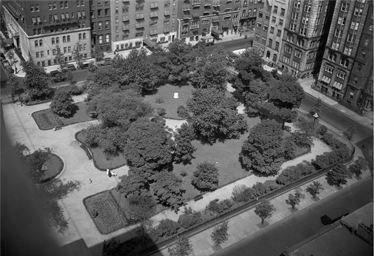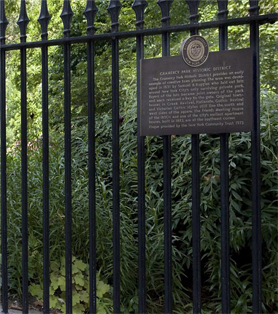Key to Gramercy
The slits, the slats, the iron spiked posts. The fog of the shrubs that cushion the vertical wrought iron blinds keep the passers-by just moving along. Curious moments can be peculiar yet often found through the black metal gates that protect this ‘hard to get,’ treasure.

Gramercy Park stashes away two acres of pathways, gardens and grass - sunken amongst the adjacent carriage houses, brownstones and buildings between East 20th and East 21st Streets. Mystical and magical is the fanciest backyard of all. ‘See,’ the fields of green?
Settle for a glimpse?
Should ‘no,’ motivate you – perhaps you’ll find solace in sixty minutes of caroling every December 24th.
From Swamp...
Real estate developer Samuel B. Ruggles bought the land that would become the Gramercy neighborhood from descendants of James Duane, a Revolutionary War Patriot and the 1st mayor of New York. Originally called "Gramercy Farm," – Duane was beyond his years, employing contemporary real estate marketing in the big apple as the property was indubitably a swampland. Nevertheless Ruggles drained the grounds in 1831 and set into motion what would become the last, private park in Manhattan.
The first planting took place in 1844. Since then the park has been immaculately maintained and sometimes even fought over. In the 1890s there were several attempts to bisect the park with a cable car, connecting Irving Place to Lexington Avenue. These attempts failed and Gramercy Park remains locked, whole and intact.
…To Swank
What was once a swamp has become one of the most pristine green spaces in New York City. Gramercy Park is surrounded by brownstones and carriage houses that date from the 1840s and 1850s. In stride, the neighborhood still bellows Olde New York and the residents harmonize that sentiment proudly. The park is also home to the largest Victorian mansion in the city—15 Gramercy Park South —now the National Arts Club.
There are fewer than 500 units directly on the park and many famous faces have been residents. Ironically, Alfred Ringling, one of the founding members of the Ringling Brothers, resided here in spite of the park's original rules (1831), which clearly stated: "no circus." It goes without saying that Ringling did not bring his work home with him.
A Walk in the Park
Make millions or make friends. Another way to get inside Gramercy Park without being a park resident or having connections; the Gramercy Park Hotel overlooks the high society playground and holds onto 12 very coveted keys. Book a stay and open the gate to one of the most mysterious parks in Manhattan.
If you don’t have the cheddar, the time, the friends or the desire to pay for a room in a city where you might very well already live, work or play – then at the least, you can join in on song every Christmas Eve. The park is open for a brief cooperation of holiday joy and caroling each year – keeping your vocal chords warm with hot chocolate refreshments.

Laws of the Land
What would a gated private park be without rules? For example, gaze through the spiked posts and you can see that jogging is only allowed at certain hours. Lose your key to enter? Cancel lunch and pay $1,000 for a replacement.
Looking to call a polo meeting – 3 riders, 4 horses – in this luxury playground? Unfortunately rules stipulate a maximum of six guests allowed. Oh, and also, no baseballs, soccer balls, footballs or frisbees.
Beyond the Fence
Ruggles succeeded in bringing a district from puddles to riches and created a quiet, distinct neighborhood that still maintains the same allure, over 150 years later. The park’s surrounding sidewalks serve as a particularly lovely part of the city for a walk, as zoning laws restrict buildings from being taller than 20 stories, and most are a modest three, four, or just five stories tall.
Gramercy is an escape from the pace of urban life. You don’t necessarily need a key to take a break, a stroll and perhaps an afternoon to smell the roses.
Confetti
Pete’s Tavern - Pull up a stool at an old favorite haunt of O Henry, Pete’s Tavern, and weave your own short story pint by pint. This pub survived the Prohibition era disguised as a flower shop. Today, the worn wood bar is a perfect place for a cold beer or triangular, fried mozzarellas. 129 E 18th St (Irving Pl), Gramercy (212) 473-7676
Irving Plaza - From the 1920's Swing Era to The Ramones, Irving Plaza has seen, and heard, it all. After a brief, 30-year hiatus from mellifluous refrains when the building was owned by a Polish Army Veterans' organization, the venue is back to shaking the walls with funky and eclectic headliners. The 1,200 person capacity makes it a perfect local spot to catch an intimate concert. 17 Irving Pl (15th St), Gramercy (212) 777-6800











